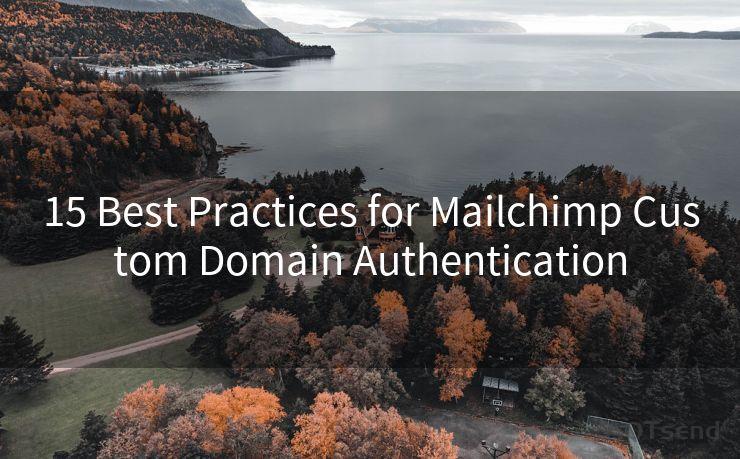15 Best Practices for Mailchimp Custom Domain Authentication




When it comes to email marketing, Mailchimp is a popular choice for many businesses. One of the key features Mailchimp offers is custom domain authentication, which can significantly enhance your email deliverability and branding. In this article, we'll explore 15 best practices for Mailchimp custom domain authentication to help you make the most of this powerful tool.
1. Understanding Custom Domain Authentication
Before diving into the best practices, it's essential to understand what custom domain authentication is. In simple terms, it involves verifying that you own the domain you're sending emails from. This authentication not only improves email deliverability but also enhances your brand's reputation.
2. Choosing the Right Domain
When setting up custom domain authentication in Mailchimp, choose a domain that aligns with your brand. Using your primary business domain is ideal, as it adds credibility to your emails.
3. DNS Settings and Verification
Ensure that your DNS settings are correctly configured for the domain you're authenticating. Mailchimp provides detailed instructions on how to set up and verify your DNS records. Follow these steps carefully to avoid any issues.
4. SPF and DKIM Records
Setting up SPF (Sender Policy Framework) and DKIM (DomainKeys Identified Mail) records is crucial for custom domain authentication. These records help verify the authenticity of your emails, reducing the chances of them being marked as spam.
5. Monitoring and Troubleshooting
Regularly monitor your email deliverability and troubleshoot any issues that arise. Mailchimp's deliverability tools can help you identify and resolve problems quickly.
6. Avoiding Common Pitfalls
Be aware of common mistakes, such as misconfigured DNS settings or incorrect SPF and DKIM records. These errors can significantly impact your email deliverability.
7. Testing Email Deliverability
Before sending out a mass email campaign, test your email deliverability using a small sample group. This helps identify any potential issues before they affect a larger audience.
8. Keeping Records Updated
If you make any changes to your domain or email infrastructure, ensure that your SPF and DKIM records are updated accordingly. Outdated records can lead to deliverability problems.
9. Brand Consistency
Using a custom domain for your emails enhances brand consistency. Ensure that your email templates, logos, and messaging align with your brand identity.
10. Subscriber Engagement
High subscriber engagement positively impacts email deliverability. Focus on creating engaging content that encourages readers to interact with your emails.
11. Managing Bounces and Complaints
Regularly monitor and manage bounces and complaint rates. High bounce or complaint rates can negatively affect your email deliverability.
12. Segmenting Your Audience
Segment your audience based on their interests and engagement levels. This helps ensure that your emails are relevant and targeted, improving deliverability and response rates.
13. A/B Testing
Utilize A/B testing to optimize your email campaigns. Testing subject lines, content, and send times can significantly improve your email performance.
🔔🔔🔔
【AOTsend Email API】:AOTsend is a Managed Email Service for sending transactional emails. Support Email Types: reminders, authentication, confirmations, notifications, verification codes, invoices, password resets, account activations, billing statements, two-factor authentication (2FA), and one-time passwords (OTP) emails, etc. $0.28 per 1000 Emails. 99% Delivery, 98% Inbox Rate.
You might be interested in:
Why did we start the AOTsend project, Brand Story?
What is a Managed Email API, How it Works?
Best 25+ Email Marketing Platforms (Authority,Keywords&Traffic Comparison)
Best 24+ Email Marketing Service (Price, Pros&Cons Comparison)
Email APIs vs SMTP: How they Works, Any Difference?
14. StayingCompliant with Regulations
Familiarize yourself with email marketing regulations, such as CAN-SPAM and GDPR, and ensure that your campaigns comply with these rules.
15. Leveraging Mailchimp's Resources
Take advantage of Mailchimp's extensive resources, including their knowledge base, support team, and community forums. These resources can help you troubleshoot issues and optimize your email campaigns.

By following these 15 best practices for Mailchimp custom domain authentication, you can significantly improve your email deliverability, enhance your brand reputation, and drive better results from your email marketing efforts.




Scan the QR code to access on your mobile device.
Copyright notice: This article is published by AotSend. Reproduction requires attribution.
Article Link:https://www.mailwot.com/p3825.html



